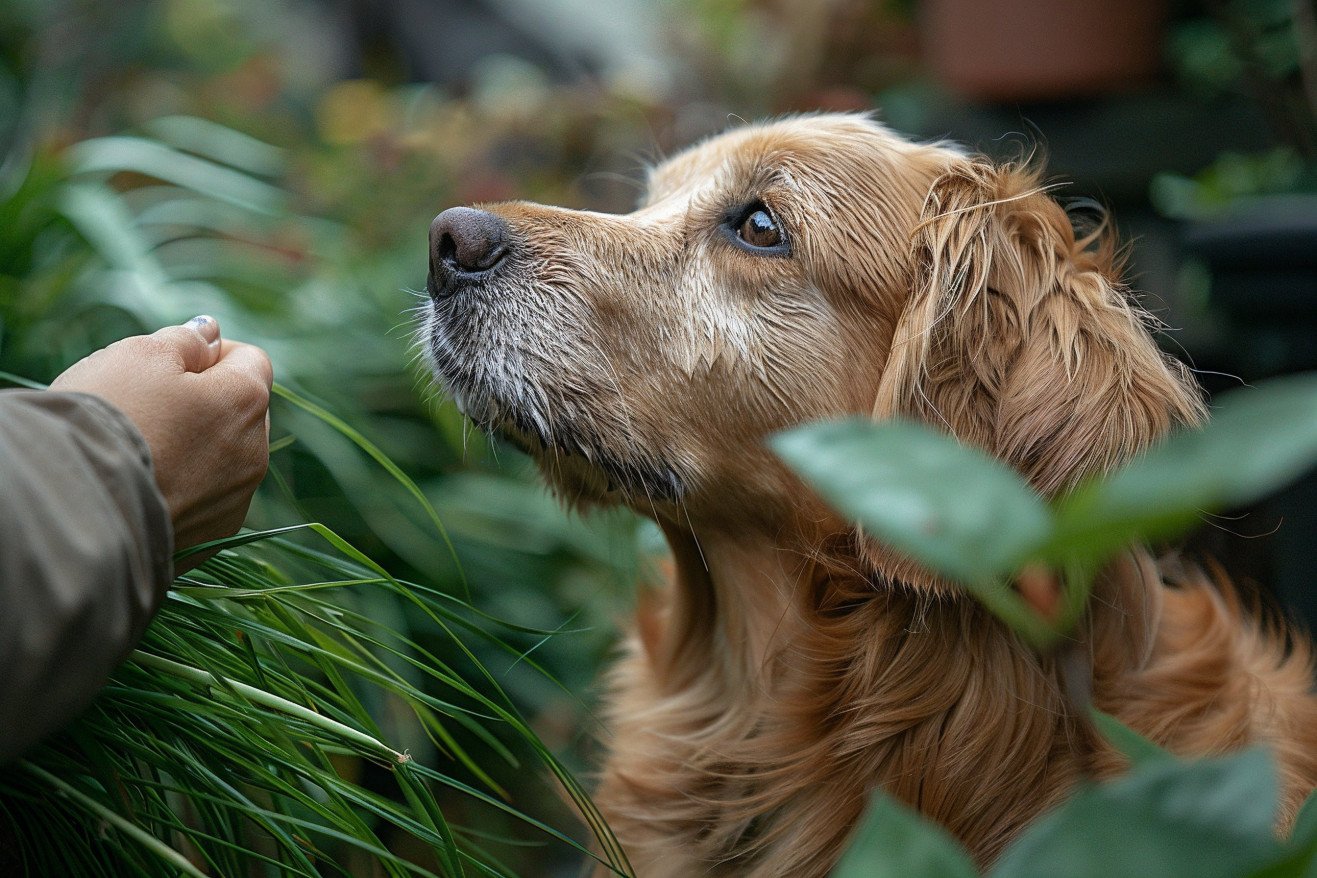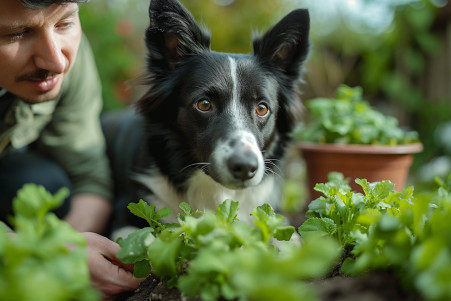Is Lemongrass Safe for Dogs? Exploring the Risks and Safe Uses
21 February 2024 • Updated 21 February 2024

Known for its bright, citrusy smell, lemongrass is a popular herb, but is it safe for your dog? If dogs eat large amounts of lemongrass, which contains essential oils and cyanogenic glycosides, it can lead to toxicity. While lemongrass is often used in dog products for its smell and as a natural insect repellent, dogs should not eat it directly to avoid an upset stomach and potential toxicity.
Our in-depth article will cover a range of veterinary perspectives and toxicological research to help you better understand the potential risks of lemongrass exposure for dogs.
We will look at research on how dogs metabolize substances, the safety of herbal products for dogs, and the toxicity of plants to assess how dogs’ bodies respond to lemongrass and the potential dangers of different lemongrass products. By doing so, we hope to offer a more well-rounded view of how to coexist with pets and plants safely.
Is lemongrass safe for dogs?
Lemongrass Can Be Toxic to Dogs
Despite its pleasant smell, lemongrass contains compounds that can be harmful to dogs. The essential oils and cyanogenic glycosides found in lemongrass are poisonous to dogs, according to the ASPCA. If dogs consume large amounts of lemongrass, they can become poisoned, leading to symptoms like vomiting, diarrhea, difficulty breathing, and fever, according to A-Z Animals.
The essential oils in lemongrass are especially dangerous because they can cause intestinal blockage, which requires veterinary treatment, according to DogTime.
Thankfully, most cases of lemongrass poisoning are mild and have a good prognosis. Treatment typically involves watching for and managing severe symptoms and ensuring the dog drinks plenty of water to help their body get rid of the toxins. If you suspect your dog has been poisoned, it’s important to contact your vet right away. With knowledge and care, the dangers of lemongrass can be mitigated to keep our furry friends safe and healthy.
What Cyanogenic Glycosides Are and How They Affect Dogs
Cyanogenic glycosides are natural compounds found in more than 3,000 plant species that can produce toxic hydrogen cyanide when metabolized.
According to the Merck Veterinary Manual, these compounds, which are found in lemongrass, can lead to cyanide poisoning in animals when consumed.
Signs of cyanide poisoning in dogs can develop quickly and include labored breathing, seizures, and bright red gums, which are a sign of blood that is low in oxygen. Cyanide poisoning is diagnosed by measuring cyanide levels in the stomach contents or tissues, which can help identify cyanogenic glycosides in the food and environment that the animal has been exposed to.
Prompt veterinary treatment is essential for successfully treating cyanide poisoning. According to the Merck Veterinary Manual, this may involve the administration of hydroxocobalamin, which binds to cyanide to form a non-toxic compound that is then excreted in the urine. Oxygen therapy is also recommended for animals that are seriously affected by cyanide.
Prevention is key to keeping our dogs safe. Be sure to be aware of the presence of cyanogenic plants in your dog’s environment and know the risks of cyanogenic glycosides so that you can prevent accidental exposure and keep your pets healthy and safe.
How to Safely Use Essential Oils Around Dogs
Despite being natural products, essential oils can pose a significant risk to dogs. Ingestion and dermal exposure to essential oils can lead to toxicity in dogs. According to VCA Animal Hospitals, even minimal exposure to essential oils can result in symptoms like difficulty breathing, ataxia (loss of control of bodily movements), muscle tremors, and drooling.
Dogs are at an increased risk of toxicity due to the rapid absorption and metabolism of essential oils in the liver, especially if they are puppies, seniors, or have liver disease.
To safely use essential oils around dogs, it’s important to make sure that you dilute them properly and avoid applying them to areas where dogs can lick them off.
While PetMD notes that oils like lavender and chamomile are considered safer for use around dogs, it’s important to consult a veterinarian to ensure that you are using them in a way that is safe for your pet.
If your dog is exposed to essential oils, it’s important to seek veterinary care immediately. The Pet Poison Helpline and VCA Animal Hospitals both stress the importance of professional medical care for dogs who have been exposed to essential oils to ensure that they receive the appropriate treatment for potential toxicity.
If you are thinking about using essential oils in your dog’s environment, make sure to put safety first and have a plan in place in case your dog has an adverse reaction. This will help ensure that you can enjoy the benefits of essential oils without putting your dog’s health at risk.
Regulatory Considerations for Lemongrass in Dog Products
Before including lemongrass in dog products, it’s important to understand its regulatory status and recommended usage. The American Pet Products Association stresses the need for regulatory compliance, including the submission of food additive petitions or obtaining Generally Recognized As Safe (GRAS) status through the FDA, for ingredients in pet products.
Due to their potential as natural flea and tick repellents, lemongrass essential oils must be carefully diluted by manufacturers to ensure safety. A 1% dilution is recommended for topical use on dogs, which means one drop of essential oil per teaspoon of carrier oil, according to experts like Dr. Ethan Sanchez.
When used in this way, these essential oils can also be used to soothe dogs, but they can cause skin irritation and toxicity if not used properly. Before using any lemongrass-based products on your dog, it’s important to consult with a veterinarian to make sure they are safe and appropriate.
It’s important to balance the benefits of natural ingredients like lemongrass with the strict safety standards necessary to use them in pet products to ensure the health and well-being of our furry friends.
Herbs in Dog Health: More Than Just Lemongrass
The world of herbs is vast, and many botanicals have different effects on dogs, some positive and others negative. A study published in PMC found that fermented turmeric, glasswort, and mugwort all improve antioxidant activities, which means they can be used to help dogs in certain ways. These fermented plant additives have been found to improve palatability and fecal microbial quality in dogs, showing promise as functional food additives.
On the other hand, lemongrass is similar to these other herbs in that it has antioxidant properties, but it is different in that it has the potential to be toxic due to cyanogenic glycosides and essential oils. That said, like the herbs in the PMC study, which have therapeutic uses that include improved food preference and digestive health, lemongrass can also be used for pest control if it is properly diluted and applied topically.
The potential uses of herbs are vast. A systematic review published in BMC Veterinary Research found that herbs like Marigold and Chamomile have been shown to be beneficial in canine dermatology. While these herbs have antibacterial and wound-healing properties that make them good for topical use, this also demonstrates the importance of understanding the specific effects and safety of each herb.
The key for pet parents is to find the right balance when it comes to incorporating herbs into their dog’s diet or treatment plan, and that means weighing the potential side effects and risks against the potential benefits.
This requires a knowledge of the potential side effects and risks as well as the benefits, to make sure that we’re looking out for the best interests of our dogs. As we learn more about the potential uses of natural, plant-based substances in pet care, we will continue to put the health and well-being of our furry family members first.
Summary of Lemongrass and Dogs
In summary, while lemongrass can be helpful for dogs, it also comes with risks due to the presence of essential oils and cyanogenic glycosides. These can lead to everything from mild gastrointestinal symptoms to severe toxicity, so it’s important to be cautious and informed.
When using lemongrass products, make sure to do so responsibly and with an understanding of the potential risks. It’s also important to talk to your vet before introducing anything new to your dog’s routine, as they can provide personalized guidance based on your dog’s health, breed, and other factors.
In general, this topic underscores the importance of using natural products in pet care while also prioritizing the health and safety of our pets. By making sure to keep our pets’ best interests in mind and staying educated, we can help ensure that our pets can enjoy the benefits of natural remedies without unnecessary risks.
This includes using lemongrass responsibly and following the guidance of a vet to ensure that it’s used safely and effectively.


